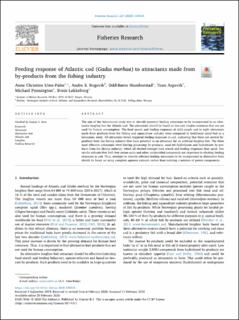| dc.contributor.author | Palm, Anne Christine Utne | |
| dc.contributor.author | Bogevik, André Sture | |
| dc.contributor.author | Humborstad, Odd Børre | |
| dc.contributor.author | Aspevik, Tone | |
| dc.contributor.author | Pennington, Michael Robert | |
| dc.contributor.author | Løkkeborg, Svein | |
| dc.date.accessioned | 2020-10-15T13:25:42Z | |
| dc.date.available | 2020-10-15T13:25:42Z | |
| dc.date.created | 2020-06-17T12:20:14Z | |
| dc.date.issued | 2020 | |
| dc.identifier.citation | Fisheries Research. 2020, 227 . | en_US |
| dc.identifier.issn | 0165-7836 | |
| dc.identifier.uri | https://hdl.handle.net/11250/2683135 | |
| dc.description.abstract | The aim of this behavioural study was to identify potential feeding attractants to be incorporated in an alternative longline bait for Atlantic cod. The attractants should be based on low-cost surplus resources that are not used for human consumption. The food search and feeding responses of wild caught cod to eight attractants made from products from the fishing and aquaculture industry were compared to traditional squid bait in a laboratory study. All attractants tested triggered feeding responses in cod, indicating that there are several by-products from the fishing industry that have potential as an attractant for an artificial longline bait. The three most effective attractants were herring processing by-products, sand eel hydrolysate and hydrolysate by-products from the shrimp industry, which all elicited stronger food search and feeding responses than squid. Our results indicate that both free amino acids and other unidentified compounds are important in eliciting feeding responses in cod. Thus, attempts to identify efficient feeding attractants to be incorporated in alternative baits should be based on using complete aqueous extracts, rather than isolating a mixture of potent components. | en_US |
| dc.language.iso | eng | en_US |
| dc.title | Feeding response of Atlantic cod (Gadus morhua) to attractants made from by-products from the fishing industry | en_US |
| dc.type | Peer reviewed | en_US |
| dc.type | Journal article | en_US |
| dc.description.version | publishedVersion | en_US |
| dc.source.pagenumber | 8 | en_US |
| dc.source.volume | 227 | en_US |
| dc.source.journal | Fisheries Research | en_US |
| dc.identifier.doi | 10.1016/j.fishres.2020.105535 | |
| dc.identifier.cristin | 1815937 | |
| cristin.ispublished | true | |
| cristin.fulltext | original | |
| cristin.qualitycode | 1 | |
